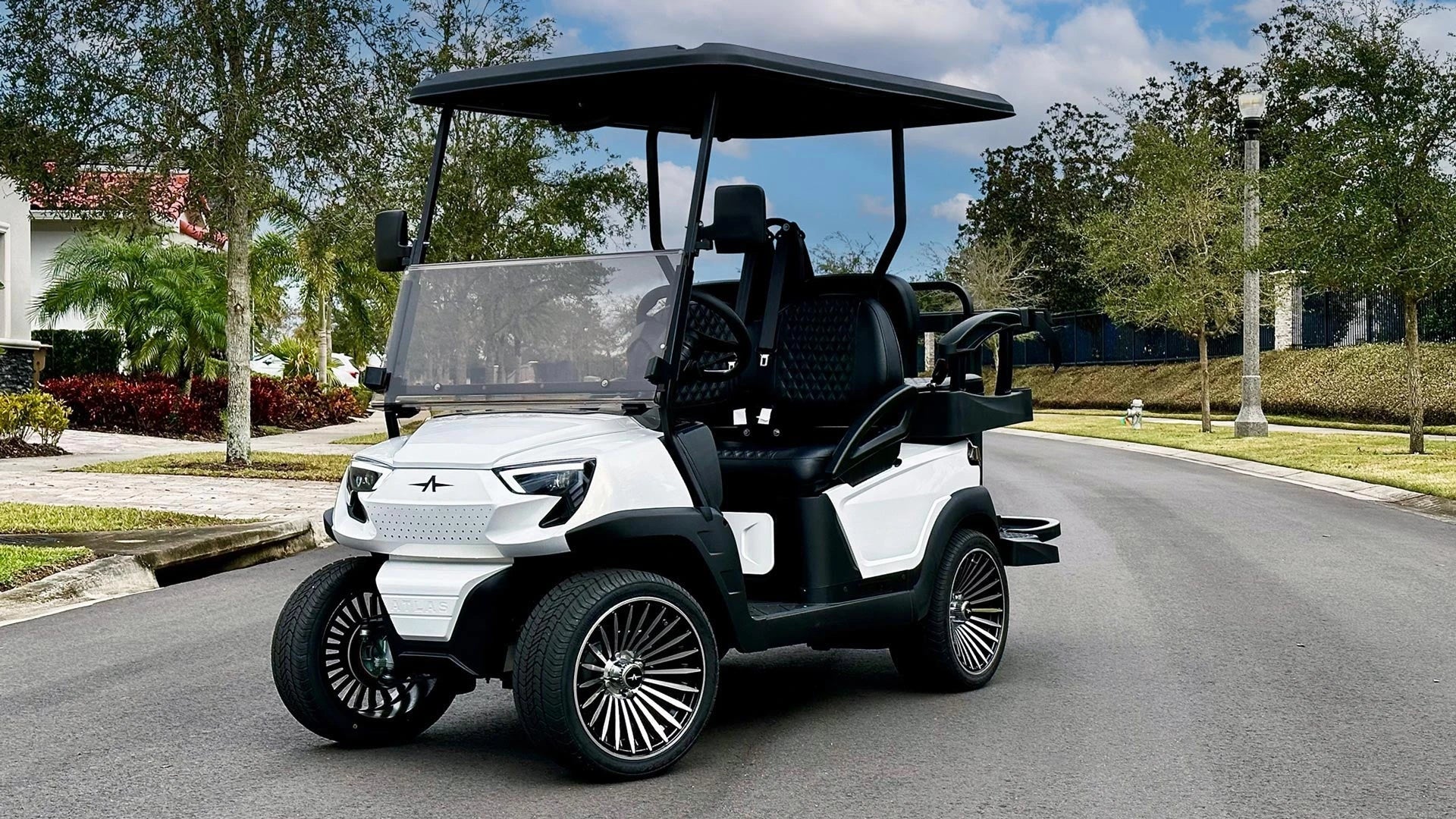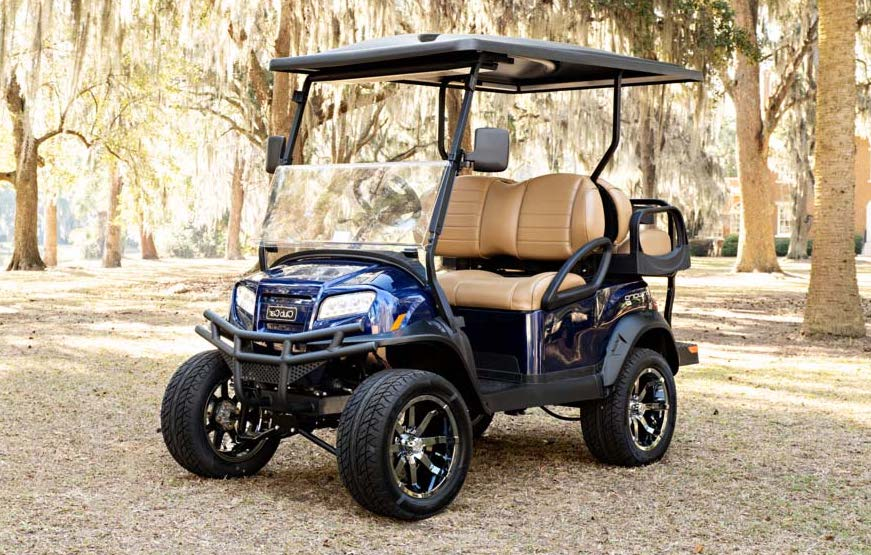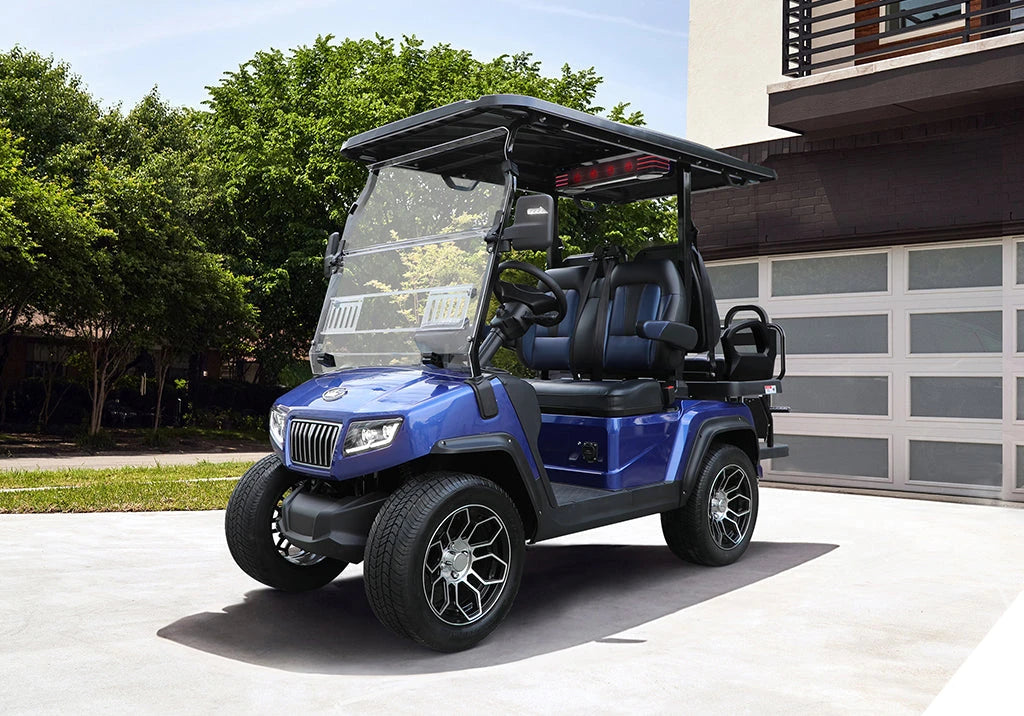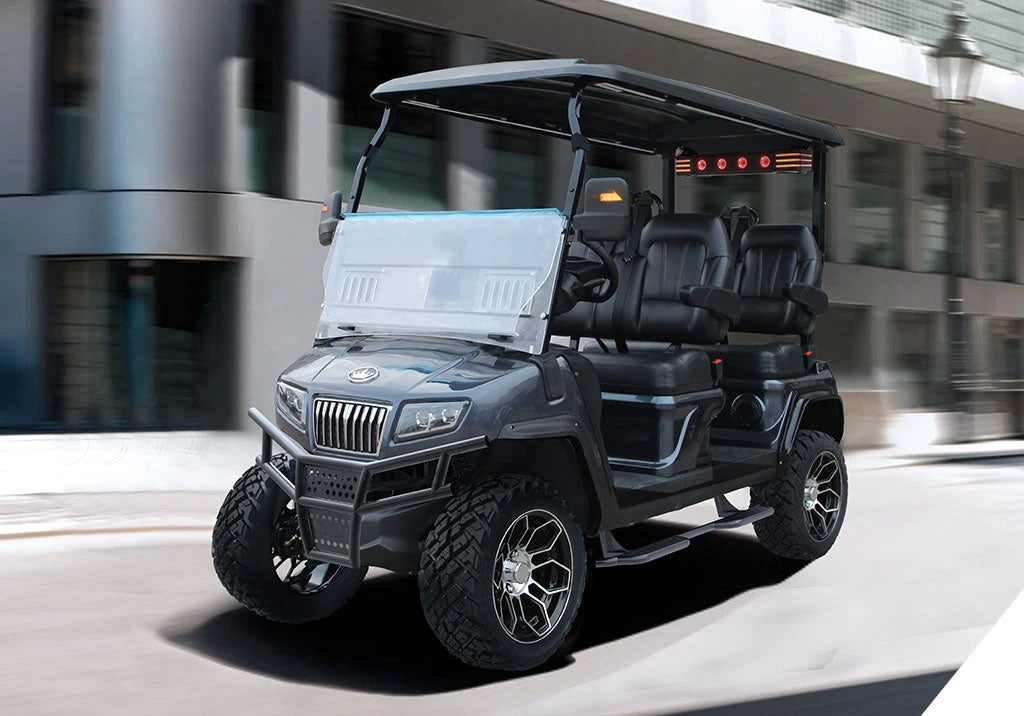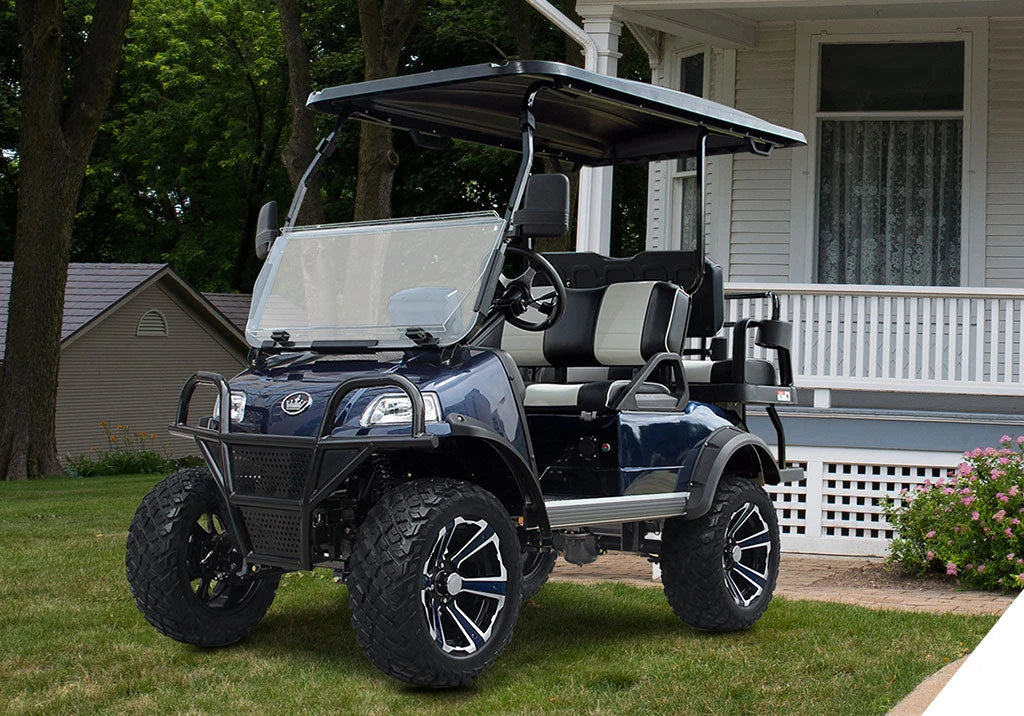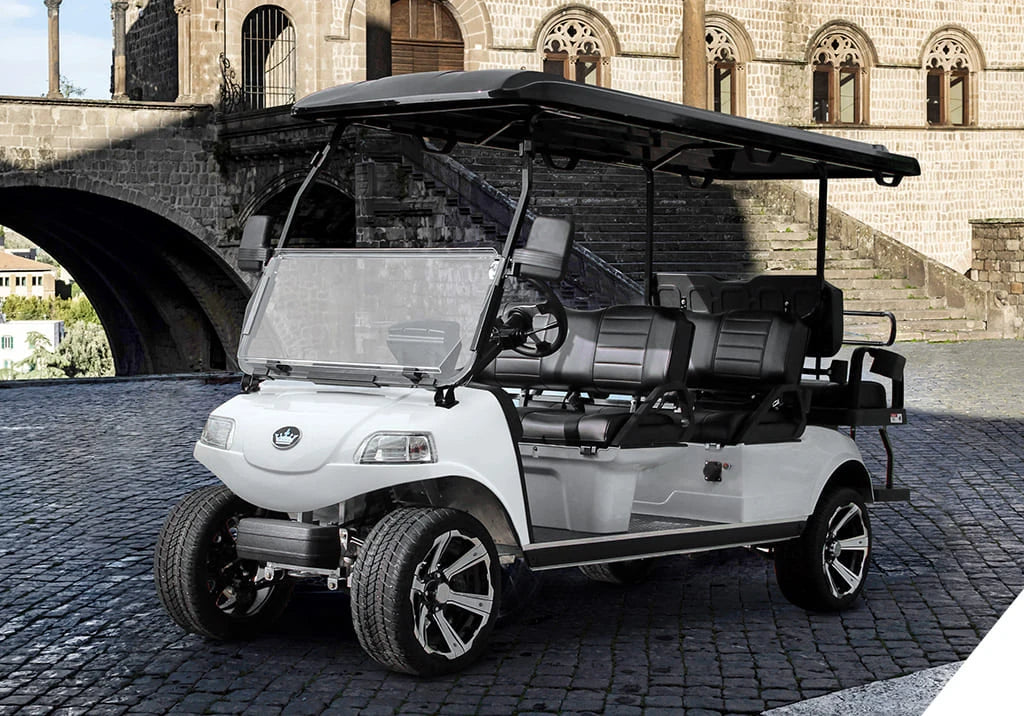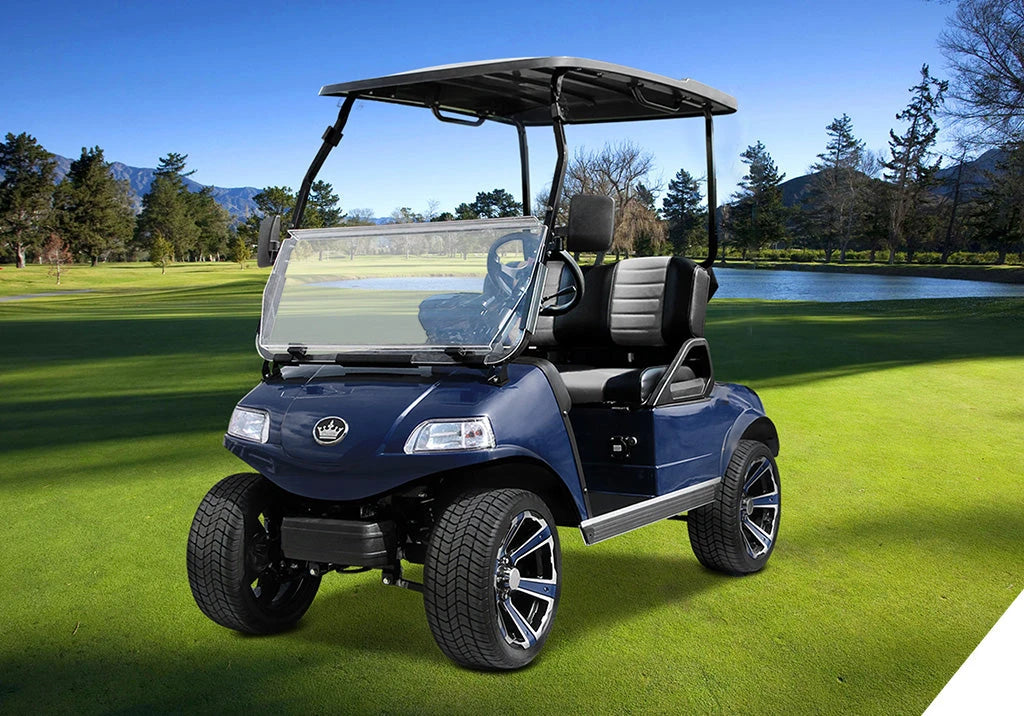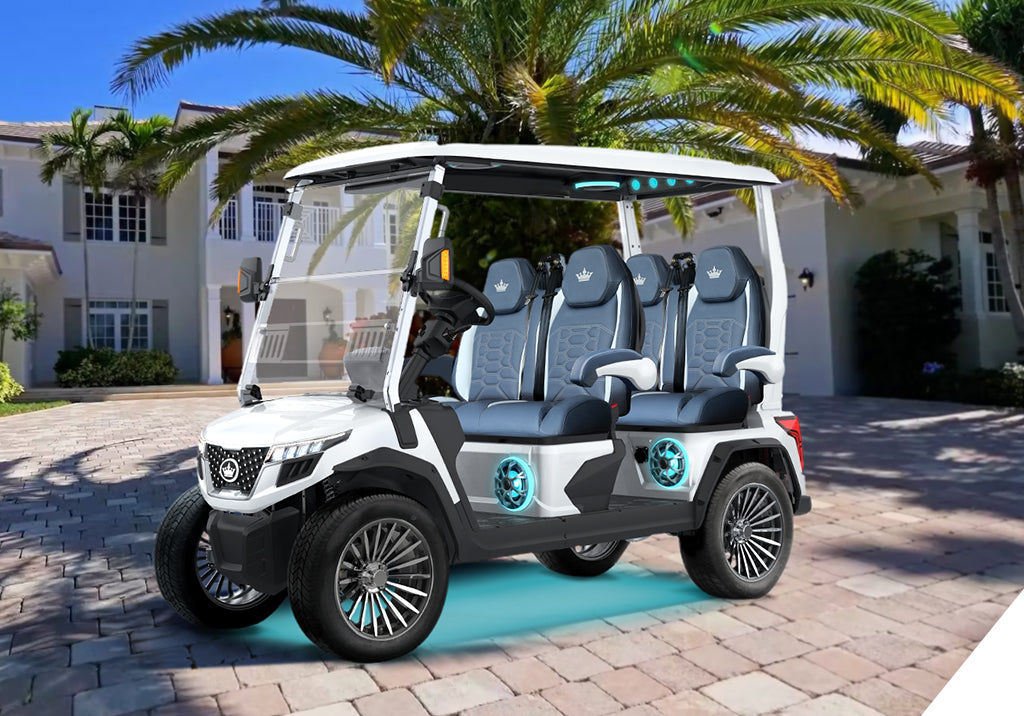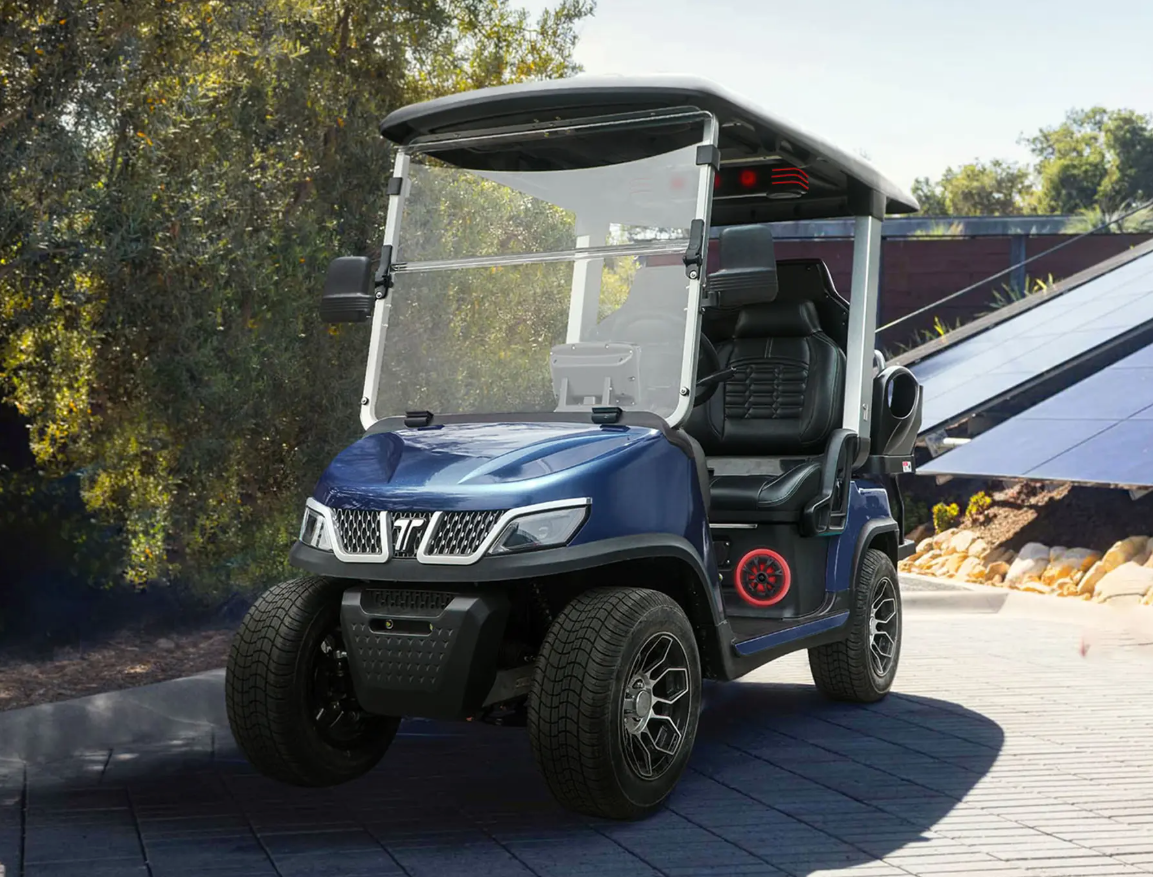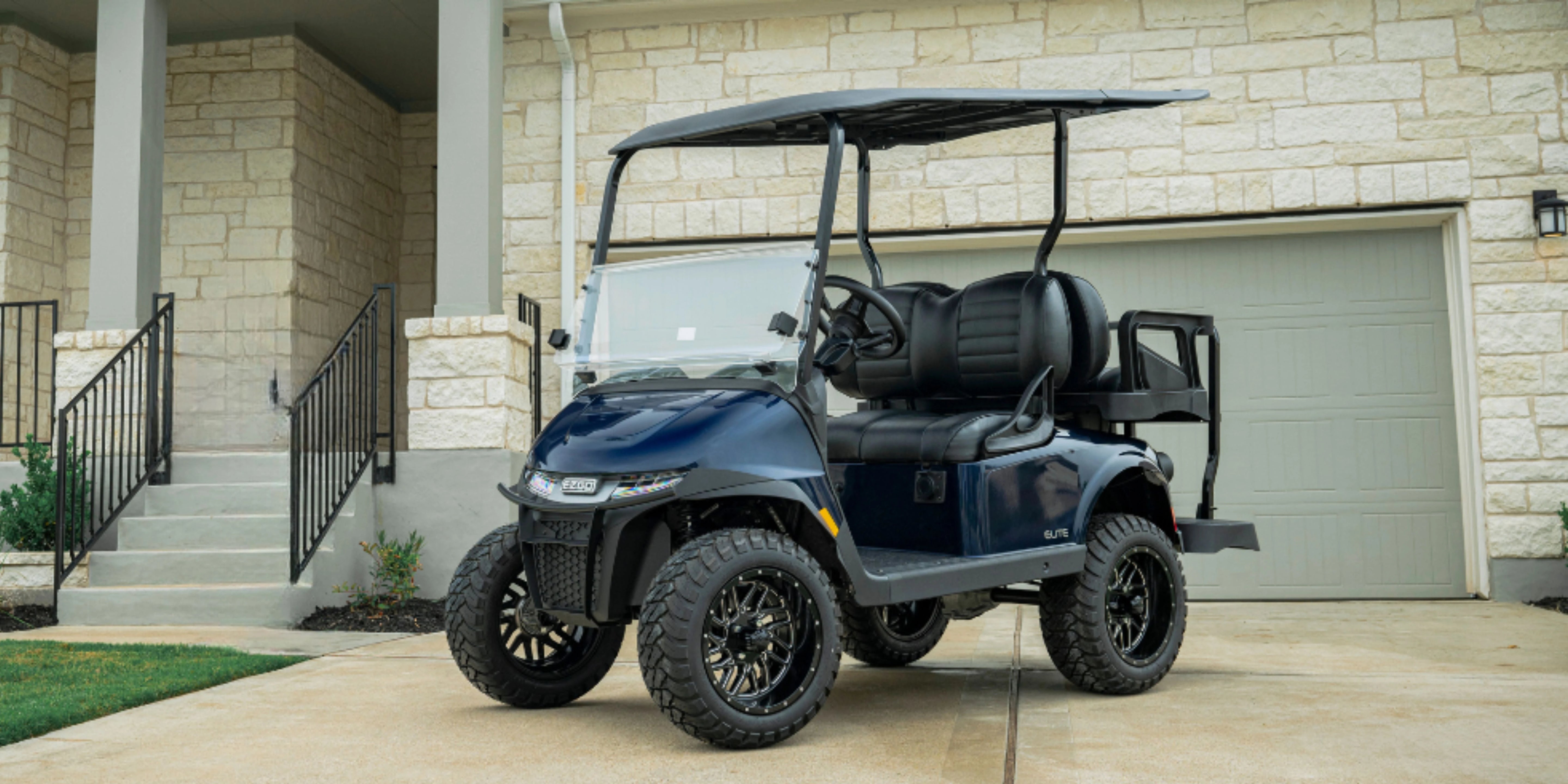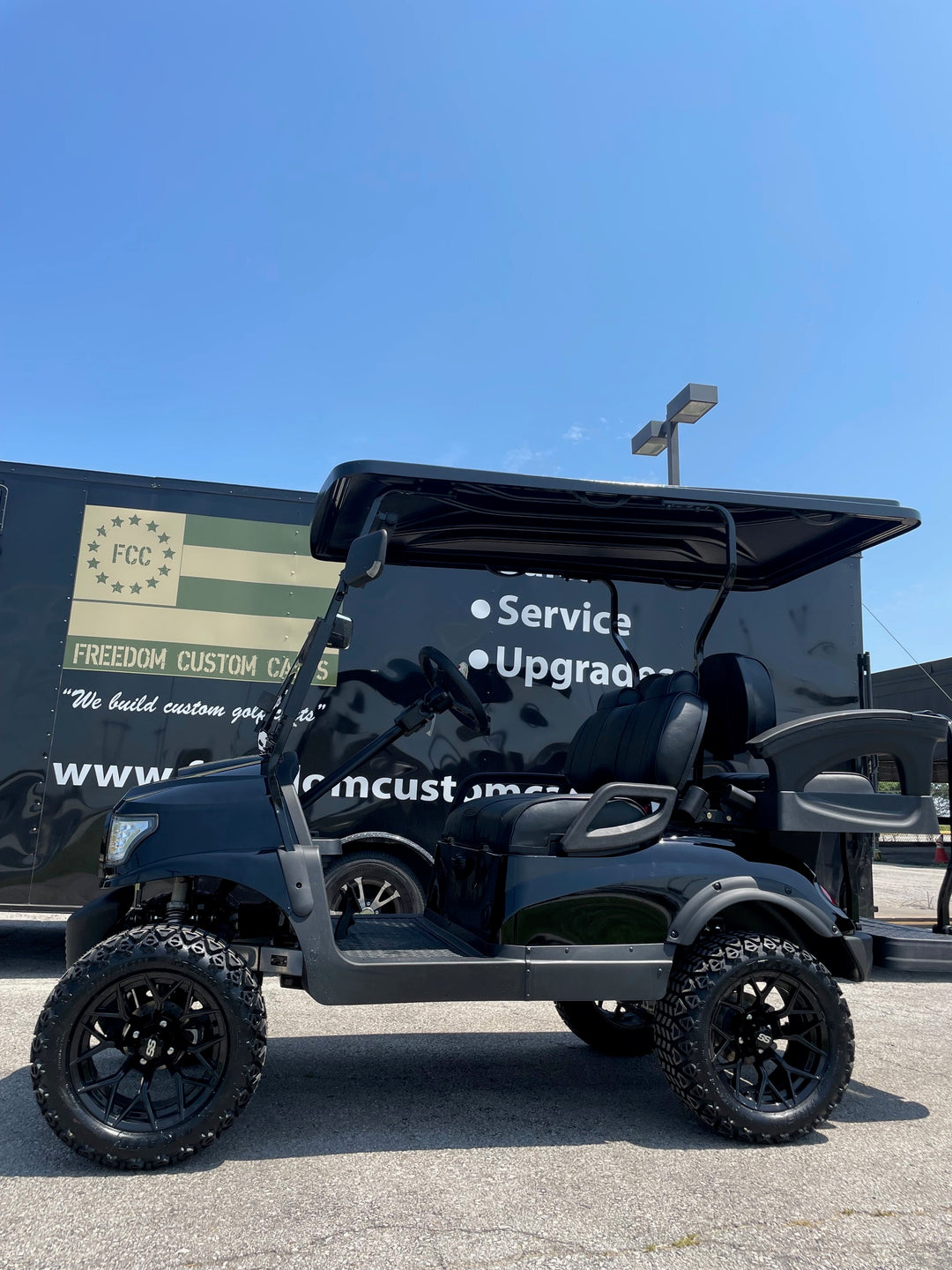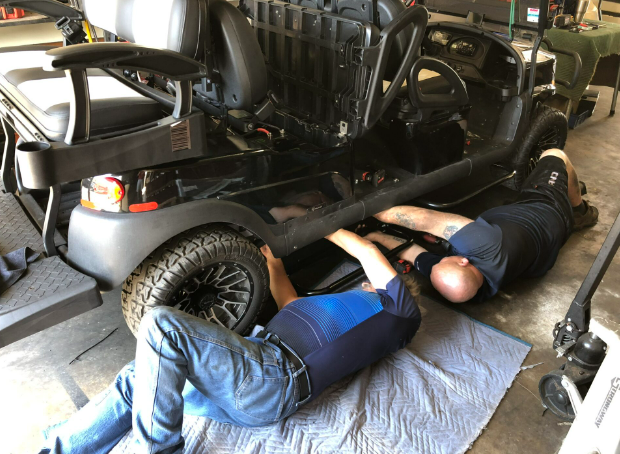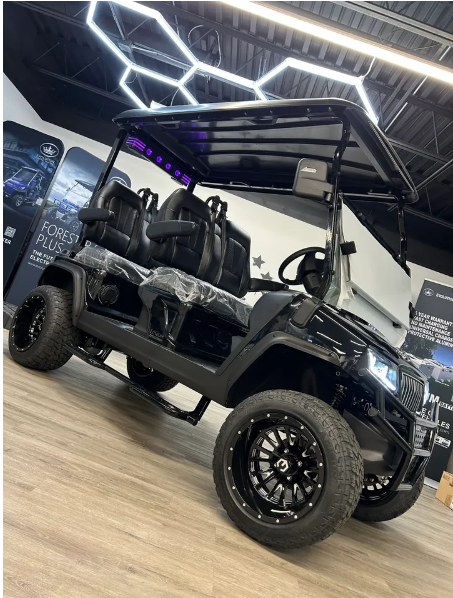FAQS
The Evolution D5 series stands out as a premium electric vehicle, blending luxury, performance, and advanced technology. Whether you're navigating the golf course or cruising through the neighborhood, the D5 offers a host of features designed to enhance your driving experience. Let's explore some of its top highlights:
- Powerful Lithium-Ion Battery: Equipped with a 48V lithium-ion battery, the D5 offers a top speed of up to 25 mph and a range suitable for neighborhood cruising or golf course use.
- Advanced Touchscreen Dashboard: The 9" multi-functional touchscreen integrates speed, gear selection, lighting controls, and an odometer. It also supports Bluetooth connectivity for music and includes a backup camera display.
- Premium Comfort Seating: The D5 features luxury seats with foldable armrests, integrated cup holders, storage pockets, and USB charging ports, ensuring a comfortable ride for all passengers.
- Enhanced Safety and Visibility: Standard LED lighting includes high beams, low beams, daytime running lights, turn signals, and brake lights, providing improved visibility and safety during night rides.
- Adjustable Steering Column: The adjustable steering wheel allows drivers to customize their driving position for optimal comfort and control.
- Optional All-Weather Enclosure: An optional all-weather enclosure is available to protect passengers from the elements, enhancing comfort during adverse weather conditions.
Note: At Freedom Custom Carts, we carry a wide selection of Evolution D5 golf carts. Browse our new inventory to see the latest models and find the perfect D5 for you
Video Reference: Discover Emily’s Top 3 Favorite Features – Click Here!
For optimal performance and battery life:
- Charge after every use or whenever the battery drops below 80% to maintain power and readiness.
- Regular charging helps maintain power, extends battery life, and keeps your cart ready whenever you need it.
- Avoid deep discharges: Letting the battery fully discharge repeatedly can shorten its lifespan.
- Use the correct charger: Always use a charger designed for lead-acid batteries for safe, efficient charging.
Video Reference: Click here for lead-acid battery care tips
Note: Freedom Custom Carts can help monitor, maintain, and diagnose your lead-acid batteries to keep your cart reliable and ready to go.
Lead-acid batteries need the correct water level to operate safely and efficiently. Here’s how to check and maintain them:
- Safety first: Always wear protective gloves and eye protection when handling batteries.
- Check water level: Open the battery caps and look inside each cell. The water should cover the battery plates but not overflow.
- Add distilled water if needed: Only use distilled water—never tap water. Add water when the batteries are completely charged. It's important to add water at the right time and in the right amount for optimal performance. Fill each cell to the recommended level, usually just below the vent well.
- Do not overfill: Overfilling can cause acid to spill and damage the battery or cart components.
- Check regularly: Inspect water levels at least once a month, and more often in hot climates or with frequent use.
Maintaining proper water levels helps extend battery life, improves performance, and ensures your cart runs reliably.
Video Reference: Click here for lead-acid battery care tips
A battery may not hold a full charge for several reasons:
- Aging or worn battery: Over time, batteries lose capacity and may not reach a full charge.
- Corroded or loose connections: Check battery terminals and cables for corrosion or looseness, and clean or tighten as needed.
- Faulty charger: If the charger isn’t working properly, the battery may not charge fully. Try using a compatible, functioning charger.
- Extreme temperatures: Very hot or cold conditions can affect battery performance and charging ability.
- Battery maintenance: For lead-acid batteries, low water levels can reduce capacity. For lithium batteries, ensure proper charging habits are followed.
Video Reference: Click here for lead-acid battery care tips
If your battery continues to have issues, have a qualified technician inspect it to determine if repair or replacement is necessary.
Note: Freedom Custom Carts can help diagnose your lead-acid batteries by running a load test and recommend replacement options, including brand-new Trojan batteries or upgrading your lead-acid batteries to lithium for improved performance and reliability.
Batteries should be replaced rather than repaired when they can no longer hold a full charge, have significant corrosion or damage, or have reached the end of their expected lifespan.
- Lead-acid batteries: If one battery in the set fails, the entire set should be replaced to maintain performance and avoid damaging new batteries.
- Lithium batteries: Replacement is recommended if the battery cannot maintain charge, shows signs of internal damage, or has reached its rated cycle life.
Note: Freedom Custom Carts can help diagnose your batteries by performing a load test and recommend replacement options, including brand-new Trojan batteries or upgrading your lead-acid batteries to lithium for longer life and easier maintenance.
Freedom Custom Carts does not replace just a single lead-acid battery. We replace the entire set because
- Mixing new and old batteries can create voltage imbalances, reduce overall performance, and shorten the lifespan of the older batteries.
- Replacing the full set ensures consistent performance, longer battery life, and reliable operation of your golf cart.
Note: Freedom Custom Carts can help diagnose your batteries by performing a load test and recommend replacement options, including brand-new Trojan batteries or upgrading your lead-acid batteries to lithium for longer life and easier maintenance.
Video Reference: Click here for lead-acid battery care tips
Proper winterization helps protect your golf cart during cold months and extends its lifespan. Key steps include:
- Charge the battery fully before storage, and disconnect it if possible to prevent discharge. For lead-acid batteries, check and top off water levels.
- Clean the cart thoroughly, removing dirt, debris, and moisture to prevent corrosion.
- Store in a dry, sheltered area away from snow, ice, and moisture. Use a cover if the cart will be exposed.
- Check tire pressure and inflate to the recommended levels to prevent flat spots.
- Lubricate moving parts like suspension and steering components to prevent stiffness or rust.
- Inspect brakes and cables to ensure they are in proper working order before storage.
- Optional: For gas carts, drain fuel or add a fuel stabilizer to prevent stale gas issues.
Note: Freedom Custom Carts recommends our Annual Maintenance service during winter, keeping your cart protected and ready for spring use.
A: For optimal performance:
- Charge after every use to maximize run time and maintain battery health.
- Avoid deep discharges (below 20%), as repeated deep discharge can reduce lifespan.
- Charge or cycle the battery at least once a month during storage or periods of non-use. This monthly “topping up” keeps the battery healthy. Allowing the battery to drop to 0% for an extended period can damage it and may result in costly repairs, including a dead cart pickup, and subsequent repairs.
- Use a charger designed for lithium batteries to ensure safe, efficient charging.
Regular charging helps extend battery life and keeps your cart ready whenever you need it.
Proper winterization helps protect your lithium golf cart during cold months and extends its lifespan. Key steps include:
- Charge the battery fully before storage. Lithium batteries should be stored above 70% charge to prevent damage from prolonged full discharge or overcharge.
- MOST IMPORTANT: Cycle or top off the battery at least once a month during storage or periods of non-use. This prevents the battery from dropping to 0% and potentially causing a dead cart.
- Store in a dry, sheltered area away from snow, ice, and moisture. Use a cover if the cart will be exposed. Note: the battery may not charge if its core temperature drops below 32°F.
- Check tire pressure and inflate to the recommended levels to prevent flat spots.
- Clean the cart thoroughly, removing dirt, debris, and moisture to prevent corrosion.
- Lubricate moving parts like suspension and steering components to prevent stiffness or rust.
- Inspect brakes and cables to ensure they are in proper working order before storage.
Note: Winter or storage is the perfect time for Annual Maintenance at Freedom Custom Carts, keeping your cart protected and ready for spring use.
Poor or squealing brakes are usually caused by worn or damaged brake pads, a faulty brake cable, or sticking brake calipers. Other factors, like low brake fluid, can also reduce braking performance. Inspecting your brakes for debris or visible wear is safe, but do not attempt to lubricate or repair the brakes yourself, as this can create unsafe conditions. If the problem continues, have a qualified technician service your brakes to ensure safe and reliable stopping power.
Some squealing or noise from your brakes can be normal and may go away after a day or two of regular driving. This can be caused by dirt, rust buildup, or water on the brakes. If the noise continues or braking performance is reduced, have a qualified technician inspect your brakes.
Note: To help diagnose issues early and keep your brakes safe and reliable, Freedom Custom Carts recommends taking advantage of our annual maintenance service.
Several factors can make your golf cart feel bumpy or unstable:
- Tire pressure: Under- or over-inflated tires can make the ride uneven or cause the cart to feel unsteady.
- Suspension issues: Worn or damaged shocks, springs, or axles can create an uneven or bouncy ride. Inspect for visible wear, leaks, or sagging components.
- Wheel alignment: Misaligned wheels can make the cart pull to one side or feel unstable. Regular alignment checks help maintain smooth handling.
- Tires: Worn or damaged tires reduce traction and stability, making the cart feel unsteady.
If these checks don’t resolve the issue, have a qualified technician inspect your cart to ensure a safe and comfortable ride. Regular maintenance can prevent these problems and keep your cart running smoothly.
Note: Freedom Custom Carts recommends our Annual Maintenance service to help diagnose issues that may cause your cart to ride bumpy or feel unstable and recommend the proper fix, keeping it safe and smooth to drive.
To ensure safe operation:
- Inspect before each use if you drive frequently, or at least monthly.
- Check that all lights turn on properly and that mirrors are secure and correctly positioned.
Note: Freedom Custom Carts will inspect your lights, mirrors, and signals as part of our Annual Maintenance service to help diagnose issues early and recommend proper fixes, keeping your cart safe and road-ready.
Freedom Custom Carts recommends a full mechanical inspection at least once a year. Even if your cart runs smoothly, annual inspections help identify worn parts, potential safety issues, and other maintenance needs before they become costly problems.
Note: Inspection frequency may vary depending on your manufacturer’s recommendations or warranty requirements. Annual Maintenance allow us to diagnose issues early and recommend proper fixes, keeping your cart safe, reliable, and ready to go.
Proper maintenance of your golf cart’s steering and suspension ensures a smooth, safe, and comfortable ride. Key steps include:
- Inspect components regularly: Check for worn or damaged shocks, springs, axles, tie rod ends, and bushings. Look for leaks, sagging, or unusual movement.
- Check alignment: Misaligned wheels can cause uneven wear, pulling, or unstable handling. Correct alignment improves safety and ride quality.
- Lubricate moving parts: Apply grease to the steering rack, suspension joints, and pivot points as recommended in your owner’s manual.
- Tire care: Ensure tires are inflated to the correct pressure and inspect for uneven wear or damage, which can indicate suspension issues.
Note: Freedom Custom Carts can diagnose issues with your steering and suspension during our Annual Maintenance service and recommend proper fixes, keeping your cart safe and smooth-riding.
If your E-Z-GO’s motor brake is locked:
- Switch the “Run/Tow” switch to “Tow” and turn the key to release the brake.
- If the brake remains locked, manually release it by repositioning the motor plugs: move terminals 1–3 and 2–4 to 1–4 and 2–3, respectively. This will disengage the brake and allow movement.
- Check the cart if it still won’t move: Inspect for weak batteries, loose battery connections, blown fuses around the controller, or a faulty solenoid or brake switch.
Emergency Option: As a last resort, the motor brake can be removed entirely to allow movement.
Caution: Only attempt this in an absolute emergency, as doing so disables all brakes on your golf cart—the brake pedal will no longer stop the cart. Have a qualified technician restore the brake as soon as possible.
- Video Reference: This video demonstrates how to release the E-Z-GO motor brake by flipping the Run/Tow switch to Tow, repositioning the motor plugs, and (for emergencies) removing the brake entirely.
Video Reference: Click here to watch motor brake removal
Note: Freedom Custom Carts recommends consulting a qualified technician if you’re unsure or if the cart still doesn’t move. Attempting repairs without proper knowledge can cause further damage.
If your Evolution D5 battery dies and the cart won’t move:
- Stop using the cart immediately to prevent further damage.
- If an outlet is available, plug in your charger and charge the cart.
- Do not attempt to push or tow the cart with a dead battery. Instead, watch this video on how to safely manually release the motor brake to move your cart if needed.
Emergency Option: As a last resort, you can manually release the motor brake to allow movement.
Caution: Only attempt this in an absolute emergency, as doing so disables all brakes on your golf cart—the brake pedal will no longer stop the cart.
Video Reference: Click here to watch motor brake release instructions
Note: Freedom Custom Carts recommends consulting a qualified technician if you’re unsure or if the cart still doesn’t move. Attempting repairs without proper knowledge can cause further damage.


